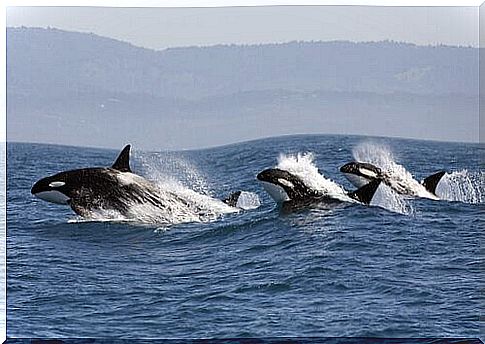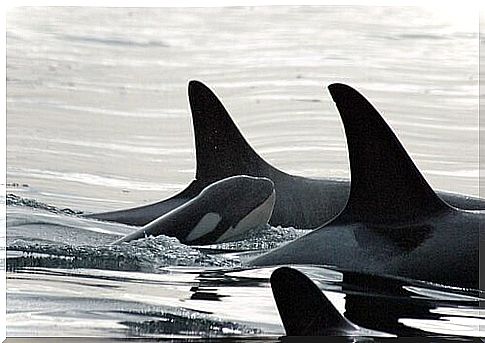Learn How Dolphins Know Where Killer Whales Are

The killer whale is one of the oceans most feared predators. This mammal, one of the most intelligent on the planet, has in its arsenal complex hunting strategies, from which only a few animals can escape. The dolphin is one of the few animals that can detect if there are killer whales nearby.
The hunting strategies of a marine predator par excellence
A lurking group of orcas is the last thing a marine animal would want to encounter along the way. Its characteristic screams, which almost resemble a human voice, are nothing but high frequency sounds, essential for communication, feeding and reproduction.
Among the sounds that this species of cetaceans makes, we can find:
- Echolocation clicks , which emits brief pulses in one or more sequences. They are mainly used for orientation and location of prey around. This type of ultrasound, which emits at a frequency between 4 and 18 kilohertz, also has some social utility.
- The tonal whistles are characteristic of different social interactions of the group. We could say that this is how killer whales talk to group members. These whistles are emitted at an average frequency of 8.3 kilohertz and generally last for 1.8 seconds.
- The modulated calls are those which might be confused with a wheeze or a human cry. With a frequency between 1 and 6 kHz, this type of ultrasound is most used during hunting, although it is also useful for communicating.

It turned out that dolphins know when to swim for their lives.
The modulated calls, those screams we’ve already mentioned and which are the only ones humans can hear, are an essential strategy for the whales they’re hunting.
There are different subpopulations of these cetaceans in the world, and their main characteristic is the type of prey they include in their diet. This is based on the type of strategies carried out by the “killer” whales.
For example, a herring group uses a technique called a feeding carousel, in which the whales take turns to reach the bottom of the herring bank and spin around themselves, while expelling air bubbles, making terrifying sounds their fangs and exposes their white bellies. In this way, the herring desperately jumps to the surface, where the rest of the group awaits.
In the case of dolphins, a team of scientists wanted to find out if, since in theory orcas are just large dolphins, dolphins would be able to understand the clicks , calls and whistles of orcas.

Dolphins and whales react in different ways
For this, the team of marine biologists sailed about 50 kilometers off the coast of North Carolina, in the United States, to see how the local fauna of dolphins and whales responded to the sounds emitted by the orcas, reproduced from the safety of the boats.
In order to verify the experiment’s effectiveness, the scientists first reproduced a series of daily sounds that generated a normal response in the population of whales and dolphins. When they reproduced the killer whale call, all the animals automatically fled in the opposite direction to the sound.
With the data obtained by the main researcher, Matthew Bowers, they were able to recreate the responses of the other cetaceans and study their escape tactics, which proved to be very different from each other. The dolphins unceremoniously flee, but the whales form a kind of barrier and confront the orcas to defend themselves.









